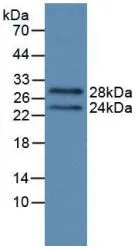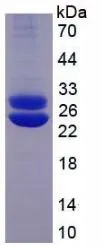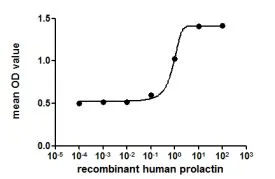
WB analysis of GTX00069-pro Human Prolactin protein (active).
Human Prolactin protein, His tag (active)
GTX00069-PRO
ApplicationsFunctional Assay
Product group Proteins / Signaling Molecules
Protein IDQ5THQ0
Overview
- SupplierGeneTex
- Product NameHuman Prolactin protein (active)
- Delivery Days Customer9
- Application Supplier NotePRL (prolactin), also known as luteotropin, is a hormone secreted from the pituitary gland and is best known for its role in enabling mammals to produce milk. PRL plays an essential role in metabolism, regulation of the immune system. According to reports, PRL also stimulates proliferation of certain cells, including MCF-7. Thus, proliferation assay of PRL was conducted using MCF-7 cells. Briefly, MCF-7 cells were seeded into triplicate wells of 96-well plates at a density of 2000 cells/well and allowed to attach overnight, then the medium was replaced with serum-free standard DMEM prior to the addition of various concentrations of PRL. After incubated for 72h, cells were observed by inverted microscope and cell proliferation was measured by Cell Counting Kit-8 (CCK-8). Briefly, 10 microl of CCK-8 solution was added to each well of the plate, then the absorbance at 450nm was measured using a microplate reader after incubating the plate for 1-4 hours at 37C. Cell proliferation of MCF-7 cells after stimulated with PRL. And PRL significantly promoted cell proliferation of MCF-7 cells. The ED50 for this effect is typically 3. 709-8. 973 ng/ml
- ApplicationsFunctional Assay
- CertificationResearch Use Only
- ConjugateUnconjugated
- Protein IDQ5THQ0
- Protein NameProlactin
- Scientific DescriptionThis gene encodes the anterior pituitary hormone prolactin. This secreted hormone is a growth regulator for many tissues, including cells of the immune system. It may also play a role in cell survival by suppressing apoptosis, and it is essential for lactation. Alternative splicing results in multiple transcript variants that encode the same protein. [provided by RefSeq, Aug 2011]
- Storage Instruction-20°C or -80°C,2°C to 8°C
- UNSPSC51180000



